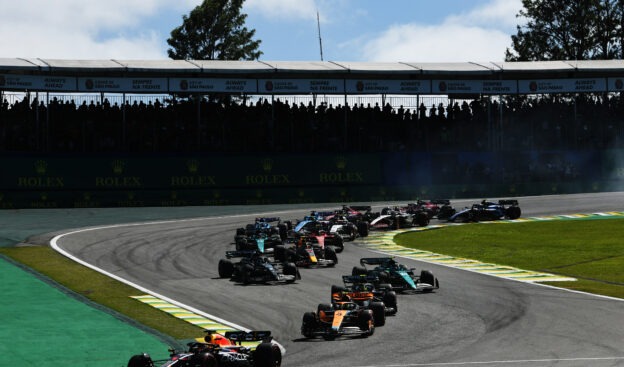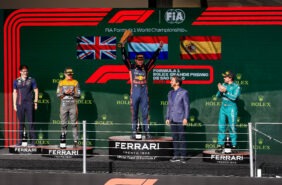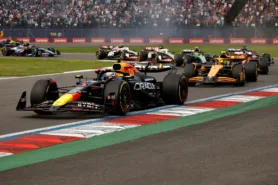All info you need to see before the 2024 Brazilian F1 GP starts

With seemingly tighter racing rules, F1 heads towards its final four races of the 2024 season. The Sao Paulo Grand Prix will close out the streak of three consecutive races, after seeing Ferrari win at Austin and Mexico with Charles Leclerc and Carlos Sainz, respectively.
2024 Championship Fight Even Got More Intense
Overall, it's been a good season with many unpredictable races. Even with the ugly racing seen in the last couple of events, we could still see a thrilling end to the season, with fights for the World Constructors' and Drivers' Championships.
McLaren (Lando Norris and Oscar Piastri) leads the WCC with 566 points, ahead of Ferrari (537) and Red Bull (512 points - Max Verstappen and Sergio Pérez).
For Red Bull, a 10-race winless streak has put them third in the WCC and Verstappen's lead among drivers isn't completely safe, with Lando Norris trying to consistently reduce the gap. Verstappen had a torrid race in Mexico, taking a couple of 10-second penalties that looked completely earned.
Still, it wasn't all bad for the Dutchman, as his moves, dirty or not, possibly prevented a win for Norris at the Autódromo Hermanos Rodríguez.
Verstappen has 362 points and continues ahead of Norris (315 points). Leclerc (291) is inching closer but there might not be enough points left for him to catch up.
2024 Sao Paulo GP Facts & Figures
The 2024 edition will be the fourth of the Sao Paulo Grand Prix and the 51st Formula 1 World Championship race held in Brazil.
Carlos Reutemann won the first Formula 1 race in Brazil in 1972 for Brabham, but the event was not part of the World Championship.
The first Brazilian GP that was part of the Formula 1 World Championship calendar came in 1973 at Interlagos. Emerson Fittipaldi, with Lotus and McLaren, respectively, took two famous wins at home in 1973 and 1974.
In its third edition, the GP was again won by a Brazilian, with José Carlos Pace winning for Brabham at the track that is now named after him. Niki Lauda won in 1976 for Ferrari, while Reutemann won again in Brazil in 1977 and 1978. The 1978 race was celebrated at Rio de Janeiro’s Jacarepaguá Circuit, giving Ferrari three straight wins in the country.
The event returned to the criticized, bumpy Interlagos for 1979 and 1980, with Jacques Laffite and Rene Arnoux winning for Ligier and Renault, respectively.
The Brazilian Grand Prix moved from Sao Paulo to Rio for the events held between 1981 and 1989 due to safety concerns regarding the Interlagos asphalt, and the overall facilities. At Rio, Nelson Piquet’s home, the event was very popular, and it produced some controversial situations early.
Reutemann won in 1981 ahead of his teammate and reigning champion Alan Jones after ignoring team orders to let the Australian by. Then, Piquet won at home in 1982, but the Brazilian driver and second-placed finisher Keke Rosberg were disqualified due to the water-cooled brakes of their Brabham and Williams cars, respectively.
The disqualification came during a heated point of the war between the Federation Internationale du Sport Automobile (FISA) and the Formula One Constructors Association (FOCA). FISA was a subcommittee of the FIA that was the governing body of F1 and motor racing.
The events of the 1982 Brazilian GP led to the boycott of the FOCA teams of the 1982 San Marino Grand Prix, won by Ferrari driver Didier Pironi ahead of Gilles Villeneuve, which started another war that ended with unfortunate situations.
Prost was named the 1982 winner for Renault, and he won again in 1984, 1985, 1987 and 1988 at Jacarepaguá with McLaren. Nelson Piquet won with the Brabham BT52 at home in 1983 en route to his second F1 World Championship, and he repeated the success in 1986 for Honda.
The 1988 Brazilian Grand Prix was Ayrton Senna’s first race and first Pole Position for McLaren, but he was disqualified due to a pre-race procedure in which he jumped into the spare car to start from the pits after the green flag was shown.
Nigel Mansell won for Ferrari in his debut race with the team in 1989, the first victory of a car with a semi-automatic gearbox. The 1989 event was the final F1 race at Jacarepaguá before the circus returned to an updated, shortened Interlagos.
Prost won again at Brazil in the return to Sao Paulo in 1990, while Ayrton Senna took arguably his most emotional win in 1991. It was his first at home and Senna won that race after struggling with the gearbox in his car and holding Williams’ Riccardo Patrese off.
Senna repeated in a wet 1993 Brazilian Grand Prix, a year after Nigel Mansell dominated in 1992 at the wheel of the FW14B. Senna had a big fight with Michael Schumacher in 1994, but he spun in the late stages and the German won the race in what has been mentioned as the final battle between the two all-time greats, as Senna passed away two races later after his unfortunate crash in Imola.
Schumacher won again for Benetton in 1995, albeit after being excluded due to a fuel infraction and being reinstated later. Williams won in 1996 and 1997 with eventual champions Damon Hill and Jacques Villeneuve.
The Drivers’ Champion had won in Brazil since 1994, and Mika Hakkinen continued the streak in 1998 and 1999, while Schumacher repeated the feat in 2000.
David Coulthard broke that streak when he won for McLaren in 2001. A big overtake by Juan Pablo Montoya on Schumacher into Turn 1 had given the Colombian the lead, but he crashed out of the race after backmarker Jos Verstappen took him out.
Michael Schumacher won in 2002, while Giancarlo Fisichella won a crazy, rain-affected 2003 event. Montoya then won in his final race for Williams in 2004, as the event was moved towards the end or the actual end of the calendar.
From 2005 to 2009, the World Drivers’ Championship was decided in Brazil, whether the race was the final of the year or not. Fernando Alonso sealed his two titles in 2005 and 2006, with the 2006 event being the last of the year, and Michael Schumacher’s final race with Ferrari.
Kimi Raikkonen won Ferrari’s most recent WDC after winning the 2007 race, beating McLaren-Mercedes’ Lewis Hamilton and Fernando Alonso.
Hamilton won his first title in one of the most epic title-deciding races ever seen in F1 history. Felipe Massa won the race for Ferrari, and with Hamilton out of the needed places to win the title, the Brazilian was set to become a World Champion at his home GP. However, Hamilton, on wet-weather tyres, surpassed Timo Glock’s Toyota (equipped with dry tyres) into the last corner of the final lap of the final Grand Prix of the season.
Ultimately, Hamilton’s fifth place gave him a one-point edge over Massa and won McLaren’s most recent World Drivers’ title.
Jenson Button sealed his 2009 World Championship for Brawn GP in Brazil, with one race to spare.
The eventual champion won again in Brazil in 2010, with Sebastian Vettel winning for Red Bull. Mark Webber won in 2011 after Vettel’s car ran into mechanical trouble (gearbox) and the German allowed Webber through.
The 2012 Brazilian Grand Prix was another showdown for the World Drivers’ Championship. Sebastian Vettel entered the race with the lead over Fernando Alonso’s Ferrari, but the German’s race was dramatic, with an early crash almost ending his race, he then recovered in tough weather conditions to finish in the needed places to beat the Spaniard. Alonso did what he needed as well (finish on the podium) to have a chance, but came short.
Both were fighting to become a three-time World Champion, and it was Vettel who eventually did it for Red Bull, achieving his third consecutive title. Vettel won the 2013 Brazilian Grand Prix to end his dominant 2013 campaign with his ninth consecutive win (a record at the time) and his then record-equalling 13th win of the year (equalling Michael Schumacher’s tally from 2004).
Mercedes dominated the event at the start of the hybrid era, with Nico Rosberg leading a couple of 1-2s in 2014 and 2015, and Hamilton doing so in 2016 on an extremely wet race which saw a great recovery by Max Verstappen’s Red Bull near the end to finish third.
Vettel won for Ferrari in 2017, while Lewis Hamilton won for Mercedes in 2018 after Max Verstappen’s crash with Esteban Ocon while the Dutchman was leading the race and the backmarker was trying to unlap himself on fresher tyres.
The Dutchman came back strong to win a crazy 2019 Brazilian Grand Prix from Pole Position for Red Bull-Honda, ahead of Pierre Gasly and Carlos Sainz, and after a good battle with Lewis Hamilton in the race.
Hamilton won the inaugural Sao Paulo Grand Prix after starting the 2021 race in 10th place. The British legend had qualified on Pole Position on Friday, but he was disqualified due to a malfunction in the DRS of his car. Hamilton finished Saturday's Sprint in fifth place after a big recovery, but he had a five-place grid penalty for Sunday's race due to exceeding engine parts.
Still, Hamilton fought the entire grid and went on to win the race ahead of his title rival Verstappen, who had pushed him off the track in a previous overtaking attempt, before the Englishman completed the move on lap 59. That win has been widely regarded as one of Hamilton's best, and probably the greatest of his career.
George Russell took his maiden victory and Mercedes' only win of the 2022 F1 campaign with a solid drive in Sao Paulo, ahead of his teammate Hamilton. While Verstappen won the 2023 edition ahead of Lando Norris. Alonso and Sergio Pérez had a tremendous fight for third place, with the Spaniard finishing ahead.
Among drivers, Alain Prost dominated in Brazil during his time, winning six races with Renault, McLaren, and Ferrari. Among teams, McLaren leads Ferrari 12 to 11 in terms of wins in Brazil.
Autódromo José Carlos Pace Track Info
The Autódromo José Carlos Pace in Sao Paulo, Brazil, has hosted the Brazilian Grand Prix 40 times, and one non-championship race. Jacarepaguá, in Rio de Janeiro, hosted the race 10 times.
Initially, the track was named Autódromo de Interlagos, due to it being located between two lakes, the Represa de Guarapiranga and Represa Billings. In 1985, the circuit was named Autódromo José Carlos Pace, in honor of the former Brazilian Grand Prix winner, who died in an airplane accident in 1977.
The original Interlagos was 7.960 km long and hosted the Brazilian Grand Prix from 1972 to 1978. The track then had some minor changes, with the circuit having a whopping 26 corners and the length varying from 7.960 km to 7.873 km.
As Formula 1 went to Rio from 1981 to 1989 and returned to Sao Paulo in 1990, the Autódromo José Carlos Pace was updated and shortened to 4.325 km and 15 corners. Since 1990, it has had some minor changes, and the current layout remains 15-corner long and is 4.309 km long.
The 2024 race will be run over a distance of 305.879 km and will have 71 laps. For the fourth year in a row, the weekend will include a Sprint race.
The lap record at the Autódromo José Carlos Pace was established by Valtteri Bottas, driving for Mercedes in 2018, with a 1:10.540 min lap in the 2018 race. Lewis Hamilton established the outright Fastest Lap in Qualifying for the 2018 race, with a 1:07.281 min lap in the Mercedes W09.
2024 Sao Paulo Grand Prix - Tyres
The dry tyres for the 2024 Sao Paulo Grand Prix will be the C3 as P Zero White hard, C4 as P Zero Yellow Medium, and C5 as P Zero Red soft.
Pirelli's press release further explained Pirelli's view of the weekend: "The Sao Paulo Grand Prix brings the curtain down on Formula 1’s long trip in the Americas, with the races at Austin, Mexico City and now Interlagos all taking place at one week intervals.
There is a common thread, a very dark one in this case, that links all three of the aforementioned tracks, namely new asphalt. However, while in Austin and Mexico City only sections of the tracks had been resurfaced, in Sao Paulo all 4.309 kilometres has been renewed, including the pit lane. The work was only recently completed and the asphalt was then thoroughly cleaned, using a high pressure water washing system that removes the sheen that usually appears on brand new bitumen and this has also increased the abrasiveness of the surface.
Therefore, the track surface will be a completely unknown factor for drivers and teams this weekend. Complicating the puzzle still further is the fact Pirelli has chosen to bring a softer trio of compounds to Brazil than last year: the C3 will be the Hard, with C4 as Medium and C5 as soft. On top of that it’s a Sprint weekend, so that there is only free practice session for teams to find the best set-up, even if, as was seen in Austin, the “short” race in fact proved to be very useful to fine tune the balance of the car for the actual Grand Prix.
At Interlagos, the lateral and longitudinal forces exerted on the tyres around the 15 corners of this anticlockwise track are medium to low in intensity and well distributed across both axles. Furthermore, the new track surface could see a lowering of lap times and, as a consequence, an increase of the stress to which the tyres are subjected.
The Brazilian weekend usually provides spectacular action. The circuit named in honour of José Carlos Pace presents several overtaking opportunities, but other random factors, such as a high chance of a Safety Car and extremely changeable weather, make the outcome of the Grand Prix uncertain and hard to predict.
Usually, the fastest strategy is a two-stop, favouring the use of the softer compounds. Last year, all bar one of the drivers chose to start on the Softs, but a red flag after the start allowed for a switch to Mediums before ending the race on another set of Softs. This year, the fact the compounds are a step softer could open up a wider range of possible strategies, making the race even more exciting.
This year marks the 30th anniversary of the tragic death of Ayrton Senna and, as was the case at Imola back in May, events and tributes will be held at Interlagos. Pirelli will be involved, in conjunction with the Senna Institute, auctioning a special version of the Pole Position Award in the Brazilian national colours, also featuring the legendary Brazilian’s logo.
Furthermore, as was the case at five previous races this year, there will be a special edition of the Pirelli Podium Cap, also in the colours of the national flag with the Senna logo, paying tribute to a driver who will forever be remembered not just by all Brazilians, but also by all those who love Formula 1."
The minimum starting pressures for the tyres will be 23.0 PSI (front) and 21.0 PSI (rear).
2024 Sao Paulo Grand Prix - Weather Forecast
Friday, Nov 1st - FP & Qualifying
Conditions: Cloudy with a shower in spots
Max. temperature: 26°C
Chance of rain: 45%
Saturday, Nov 2nd - Sprint Shootout & Sprint Race
Conditions: Cloudy
Max. temperature: 26°C
Chance of rain: 25%
Sunday, Nov 3rd - Race
Conditions: Cloudy and humid
Max. temperature: 26°C
Chance of rain: 25%
Who will be on the 2024 Sao Paulo Grand Prix podium?

Race winner Max Verstappen celebrates on the podium during the F1 Grand Prix of Brazil at Autodromo Jose Carlos Pace on November 05, 2023 in Sao Paulo, Brazil
The race in Brazil could be interesting, with possibly the three top teams having true chances of going for the win on both Saturday and Sunday. Ferrari is coming hot into the weekend and is only 29 points behind McLaren in the World Constructors' Championship.
While Ferrari has consecutive wins, the team also managed to finish on the podium with its two drivers. McLaren probably hasn't had enough in the last two races to win, although its chances in Mexico would have looked better without the Verstappen incident. Still, Lando Norris should be among the contenders for the two races this weekend to reduce the 47-point gap to Verstappen in the WDC.
On his end, continued Top 5 finishes will be enough for Verstappen to secure the championship, and that's where Red Bull and the Dutchman would love to see Mercedes continuing to struggle with its cars.
The prediction for the Top 3 of the 2024 Sao Paulo Grand Prix is 1. Lando Norris, 2. Charles Leclerc, 3. Carlos Sainz.
✅ Check out more posts with related topics:













I predict Sainz keeps momentum from the last round & wins again from pole position, followed by Leclerc & Norris, respectively, to fill the top 3.
✅ Checkout the latest 50 F1 Fans comments.